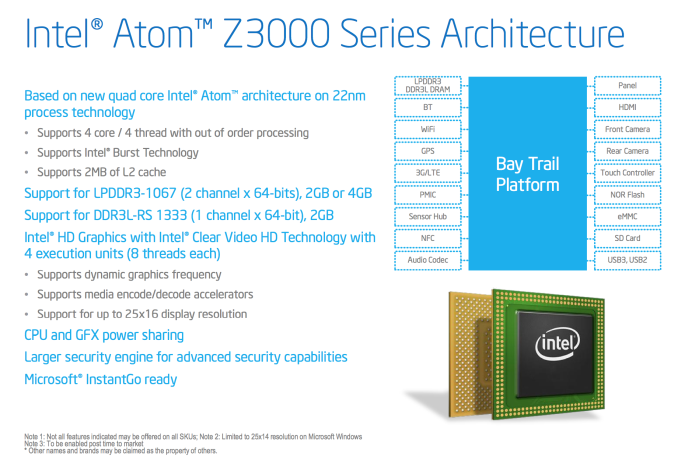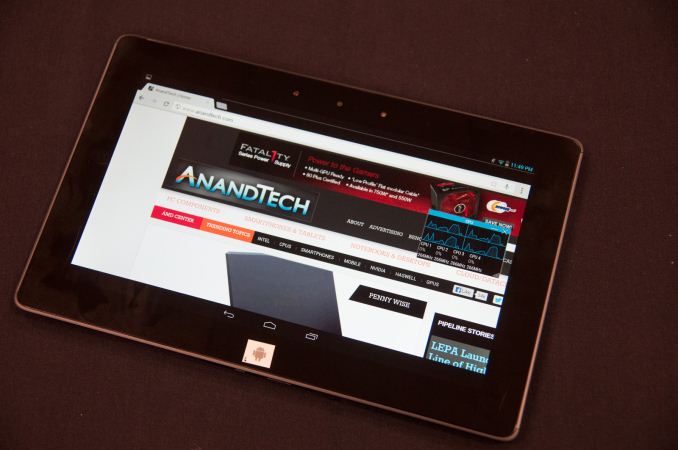The Bay Trail Preview: Intel Atom Z3770 Tested
by Anand Lal Shimpi & Brian Klug on September 11, 2013 12:00 PM ESTFinal Words
At its Silvermont disclosure, Intel promised performance better than any other ARM based core in the market today. Looking at our Android results, Intel appears to have delivered on that claim. Whether we’re talking about Cortex A15 in NVIDIA’s Shield or Qualcomm’s Krait 400, Silvermont is quicker. It seems safe to say that Intel will have the fastest CPU performance out of any Android tablet platform once Bay Trail ships later this year.
The power consumption, at least on the CPU side, also looks very good. From our SoC measurements it looks like Bay Trail’s power consumption under heavy CPU load ranges from 1W - 2.5W, putting it on par with other mobile SoCs that we’ve done power measurements on.
On the GPU side, Intel’s HD Graphics does reasonably well in its first showing in an ultra mobile SoC. Bay Trail appears to live in a weird world between the old Intel that didn’t care about graphics and the new Intel that has effectively become a GPU company. Intel’s HD graphics in Bay Trail appear to be similar in performance to the PowerVR SGX 554MP4 in the iPad 4. It’s a huge step forward compared to Clover Trail, but clearly not a leadership play, which is disappointing.
The big unknowns are things like video decode power efficiency, perf and quality of their ISP and idle power efficiency vs. Qualcomm.
Bay Trail looks like a good starting point for Intel in mobile, and the performance of Silvermont makes me excited for Merrifield in phones next year. What Intel needs to do going forward is simply continue to iterate and execute for the next few generations after Bay Trail and it will have a real chance at success in mobile.
My biggest concern is about the design wins we see based around Bay Trail. Although Intel is finally in a spot where it can be in devices on the market, none of those devices thus far have been any good. Bay Trail is attractive enough to garner more design wins for certain, the question is whether or not the quality of those wins will improve as well. In the tablet market there’s the iPad and the Nexus lines that are really the most interesting, and I don’t expect Bay Trail to be in either. Whether or not the quality of the rest goes up this generation and we find a Bay Trail in one of those devices remains to be seen.












190 Comments
View All Comments
jfinely - Wednesday, September 11, 2013 - link
In the graphics the S800 is ahead but on the cpu side Baytrail dominates.So when you look at the SoC as a whole, it is too close to call.
The difference maker could be the energy consumption
Baytrail should run less energy consumption
phoenix_rizzen - Monday, September 16, 2013 - link
Really? Have you seen the battery use benchmarks Anandtech has done on the S800 in a phone form-factor? If not, go read through some of them. The S800 SoC doubles, sometimes triples, the S4Pro and S600 SoC battery life. And that's in a phone! Add in the extra thermal headroom of a tablet, along with the larger battery of a tablet, and I fail to see how Bay Trail can compete.zeo - Thursday, September 19, 2013 - link
The SD800 is limited in a phone and not running at the full possible performance and so is using a lot less power than it would in a tablet! Not to mention the smaller, typically around 720P screen on the phone versus 1080P on the tablet also tends to reduce power consumption for the phone...Really, the Clover Trail was already shown by Anandtech to be more energy efficient than many Cortex A9 ARM SoCs like the Tegra 3. While Bay Trail improves that power efficiency by about 5x!
Even while providing over twice the performance of Clover Trail and with double the number of cores, the Bay Trail still only uses about the same or less power than Clover Trail.
Besides, the phone optimized Merrifield for ATOM isn't out yet... So you're comparing the phone optimized SD800 to the tablet optimized Bay Trail T!
The Nokia Sirius 10" Tablet was going to be released with a SD800 and only claimed up to 10 hours run time! Bay Trail 10" tablet like the upcoming Asus T100 on the other hand claim up to 11 hours, albeit with a lower resolution screen!
While Anandtech showed extremely good performance per watt for Bay Trail in this review...
So at the very least they're very competitive on power efficiency and it's not a issue as you suggested!
Nagorak - Wednesday, September 11, 2013 - link
Well, you know, even if that were true, the point would be it's made by Intel and not Qualcomm. Intel doesn't get money from Snapdragon CPU sales, hence their interest in making their own CPU.In terms of CPU performance, it looks to me like Intel has really delivered here, but the graphics performance is still holding them back. Still it's hard to say Snapdragon smokes the new Atom. At worst they trade wins depending on whether it's CPU or GPU.
jasonelmore - Thursday, September 12, 2013 - link
i lol'd thankszeo - Wednesday, September 11, 2013 - link
Six months? Both Toshiba and Dell already announced 8" Bay Trail Tablets that will be released by the end of October of this year!Asus also announced a T100 2 in 1 tablet with keyboard dock... And you can't run the full range of software on a ARM SoC, but Intel can run any flavor of Windows, Android, Linux, or even OSX... They're also scaling up to higher end versions with even more performance that'll be low cost alternatives to Haswell...
fteoath64 - Thursday, September 12, 2013 - link
Same impression I got. For Intel to spend another 2 years to retool Atom to this stage yet, outgunned by both S800 and Tegra4 is really a POOR showing for the king of CPUs!. Many have said, just lay Atom to rest and continue with Haswell core "slash n burn" to cut down on power consumption and replace the pathetic MediaHD gpu with a variant of Rouge6 from Imagineering. Just as what Apple has done. The fact that Intel kept wanting to retain x86 compatibility shows, its constraints to out-do Arm in this low power game. Even on 22nm process the results are way LESS than passing grade (I would give 45% mark which is a FAIL still). Marginal but fail no doubt!. This chip should have been out 3 years ago and things might not have looked this bad. I guess Intel going with Quark might spur something useful. But I doubt it as Arm M3 is a mighty little thing just as hard to crack as the Cortex brothers .... Nice try Intel but fail still. Sorry.tech4real - Thursday, September 12, 2013 - link
if you read the results carefully, you can clearly see this atom's CPU muscle is stronger than S800.As for Tegra4 in Shield, please remember it's a fan device(meaning the power budget is >5W, a lot higher than this baytrail device), which makes the performance comparison unfair. Even then, some reviews find that baytrail trades blows with shield. To me, it shows significant perf/W advantage for silvermont core against both krait and A15.
you can find more benchmark results at:
http://techreport.com/review/25329/intel-atom-z300...
http://www.pcper.com/reviews/Processors/Intel-Atom...
monstercameron - Friday, September 13, 2013 - link
this tested baytrail platform was an intel prototype, so comparing it to a shipping product is a bit skewed, also tegra 4 can be passively cooled, it is just that it needs active cooling to keep its performance stable in the shield formfactor. Note that the tegra 4 has a better gpu than baytrail [higher performance higher power] which might be adding to the overall power draw.tech4real - Friday, September 13, 2013 - link
i agree on the point it's an intel prototype, so to be fair we need to wait till next month to really try on a shipping baytrail-T product. But as for tegra 4, my sources are saying even with CPU only heavy load(to remove the GPU effect), its power dissipation is still too high. Thus makes tegra4 pretty weak in terms of perf/W.I am sure we will get the clear picture next month as they come out.